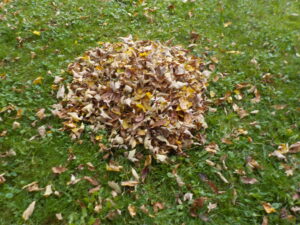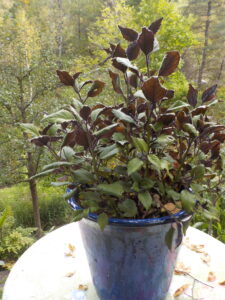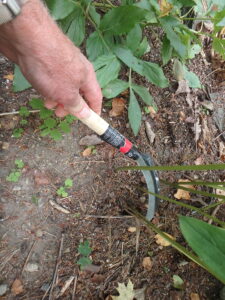Putting the Garden to Bed
Posted on Thursday, October 20, 2022 · Leave a Comment
Frost has already lightly brushed my garden, and hard frost is not far behind. Even in warmer spots it is good to start getting ready for winter. Let’s look at some of the key activities for all of us.

Save your fall leaves for use as mulch
First, remember to visit and support your local garden center. They want to unload as many plants now as they can – perennials, shrubs and trees. So they are discounting plants, often 25% or more. I recently got some big burr oaks at a 50% discount– a considerable saving. And it is not too late to plant.
I have read that woody plants store up food all summer when the sun is bright, and use some of it now to extend their roots out away from the main stem. So I like to plant trees in the fall especially since it is cooler and more rain is falling now than in mid-summer. Planting in spring and summer is good, too, since a tree has longer to get established before winter, and some gardeners insist that fall planting is risky. If you plant a tree, be sure to spread 2 inches of mulch around the tree to keep the roots warm as late into the fall as possible.
You may have already done so, but let me remind you anyhow to bring in your houseplants that have summered outside. Do it now, not after frost even for plants like rosemary that can sustain a temperature down to 25 degrees or so. Aphids are the biggest pest on houseplants. Outdoors they are eaten up by other insects or washed off by heavy rains, but indoors a plant that is already sulking is ripe for an infestation.

Wash houseplants with hose before bringing them inside to get rid of aphids
Use your hose to wash not only the tops of leaves, but the underside as well. And wash the surface of soil in the pot – do this by laying the plant on its side. This will help you to get rid of eggs and adult aphids, though a few elude me every year. Watch for aphids or their sticky droppings on leaves. If you see some, spray with Safer Soap to dehydrate the aphids and knock them dead. Repeat as necessary.
Your least favorite fall activity may be weeding and plant cleanup, though I kind of enjoy it. It is very important to remove rotten fruit, stems and leaves of tomatoes, potatoes, and vine crops as they often have mildew or fungus by now. Be sure to get them out of the garden ASAP. And if you have had bugs on any plants, put them in the household trash or on a burn pile. You don’t want them wintering over in the garden or the compost pile. You don’t have to wash tomato cages, their diseases won’t winter over on them.
Getting rid of weeds now is important, but so is covering the soil with leaves or mulch so those seeds blowing in the wind don’t land on bare earth and settle in, ready to grow in early spring – even before you have thought about planting next year’s veggies.
Fallen leaves are the best mulch available, and free. You can compact them and make them easier to move to the garden by running them over with the lawnmower. Or you can just rake them up and onto a tarp. They will settle in and not blow around if you do this just before a nice rain. But you can use grass clippings now, before leaves have all fallen. And if you use a mowing service, ask them to leave the leaves and grass clippings for you to use. But do that only if they do not use any chemicals on the lawn. You don’t want any chemicals in your garden.

This harvest sickle will slice through stems quickly and is easily rotated
Cutting back the flower gardens is hard work and time consuming if you have extensive flower beds as I do. Many gardeners use their hand pruners and clip away, stem by stem. Not me. That is very hard on your paws. I like to use a curved serrated knife or small “harvest sickle” to do so. I grab a handful of stems with my left hand, then slice them off with my right. One motion, and no work for my fingers the way pruners would do.
You might also consider using a string trimmer to cut back big beds. I’ve done it, but don’t usually do so. It’s fast, but less precise. And I like to leave some flower stalks standing, things with seed for winter birds like chickadees and finches. I leave black-eyed Susans, purple cone flowers, sunflowers and anything else that looks tasty from a bird’s eye view.
The most radical way of cutting back flower beds is to use a lawnmower. I have one long, wide bed that is full of aster, Joe-Pye weed, goldenrod, giant foam flower and turtle head. In late fall I used to put the blade of my riding lawnmower up as high as possible and ride over it, mowing it all down. Now I no longer have a riding mower, and I doubt my battery mower would chomp through it. I will have to use the string trimmer, I guess. It’s a bed about 75 feet by 10 feet, so a motorized tool helps.
If you have dahlias and other tropicals growing in the ground and want to save the tubers for next year, only dig them up after a frost or two. Bring them into the basement or barn after you have shaken off most of the soil. I don’t wash the tubers, as a little soil will help keep them from drying out too much.
I store my dahlia tubers in a cold basement that doesn’t freeze. I put them in a box or tub with some sphagnum moss that is lightly moistened, and spray some moisture on in February. You can also store them in a plastic bag with holes punched in it and some bedding sold for gerbils in it, lightly moistened.
I love winter, but I’m always sad the morning after the first hard frost. Most of my annuals will have fallen, like wounded soldiers. But I also know that at my age, a season of rest from the garden will be good, too.





